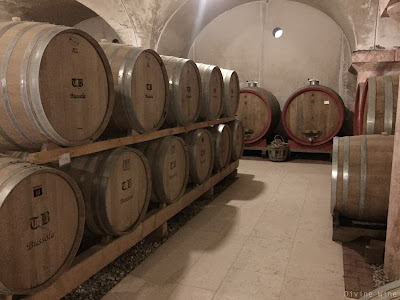 |
| Amarones age a minimum of three years in this picturesque cellar at Bussola's . |
Valpolicella
wines come in a wide range of prices: in a European supermarket a bottle of
basic Valpolicella might cost just a couple of euros, while Amarone starts at
minimum of 20 euros, wherever you might find it. What makes these wines so
different, even though they are made from the same grape varieties in the same area?
First,
there unfortunately still is a marked overproduction of modest quality basic
Valpolicella that comes from the plains of Po river valley, while the grapes
for Amarone are grown at the best, hilly vineyard sites. Also, the current
popularity of a more fruity wine style has made Amarone a popular brand. The
main reason for Amarone’s high value, however, is the huge demand of skilled
care and labour it requires throughout its production.
Valpolicella
normale is made of lesser quality grapes, and they are often the ones that have
been excluded from Amarone production. Hence, even if a grape were grown on the
best site, its juice wouldn’t necessarily end up in a bottle of Amarone. Working
at the vineyards on steep slopes is by definition manual. And the more
ambitious the Amarone producer, the more intensively fine tuned this manual
work becomes. Just for example, during the harvest the grapes are not only hand
picked, but also several passages are made through each vineyard to pick the
grapes when they are optimally ripe.
Precision
is especially vital already at the stage of grape picking for successfully
producing high quality Amarone. In case any grey rot infected or damaged grapes
are picked, a mouldy catastrophe takes place in the drying room. This is why only
healthy and optimally ripe grapes are picked. Subsequently, the grapes are delicately
carried in single layers to avoid their skins from breaking, to the drying room.
Only intact grapes survive the four months or more of drying without becoming mouldy.
And while only the best of the best grapes are accepted for making the Amarone,
a third of the juice of these grapes is lost through evaporation in the drying
process.
Amarone
producers go to great lengths to avoid negative grey rot in the drying room.
Many drying rooms are equipped with ventilators in addition to building the
rooms open for natural ventilation that wind provides. In case noble rot is
favoured for aromatical reasons, as might be the case for Recioto, the humidity
needs to be optimised to favour its development. However, this is strenuous
work - the line between noble and grey rot is indeed fine. Whether or not noble
rot is desired, the battle against grey rot is constant during the four months
of drying the grapes for Amarone and Recioto. Of these four months, the first
ten days are the most vulnerable period. Grey rot infected grapes need to be
removed immediately as they appear to avoid it taking over the entire harvest
and spoiling it.
After the
thriller in the drying room it’s the time for fermentation. However, the
winters of Northern Italy aren’t warm, especially in the mountain foothills.
When the drying of the grapes is finished, the coolest time of the year is at hand;
yeasts are reluctant to wake up from their winter hibernation. Under these
circumstances getting the fermentation going certainly can’t be taken for
granted. Once the fermentation is on its way, it takes long because of the low
water content of the must. Long fermentation increases the risk of spoilage.
And still, after a successful fermentation, plenty of time, cellar and barrel
space - and work - is required as these great wines of Valpolicella are aged at
length, and typically released after 5 years of their vintage of production.
It becomes
easy to understand the price point Amarone is sold at when considering the
hurdles its producer needs to face before ending up with a complete wine. Clearly,
not everyone is suited for taking on this kind of a job. You can just imagine
how excited I was to be welcomed to visit one of the most ambitious Amarone and
Recioto producing wineries in Valpolicella, Tommaso Bussola. I’ll share this
experience on my next blog post. You are most welcome to join me
on this Divine Wine visit!
 | |
| Bussola's entry-level Amarone from the nearly perfect vintage of 2009. |
No comments:
Post a Comment